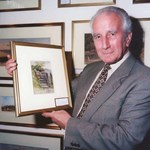It is an impressive thing. Not only is it a full chromo of some six or more separations, making it very colourful, it has a good factory scene with no motor vehicles to emphasise age. In the distance an Alloa-Dunfermline (Upper) passenger train is passing to add spice to pre-Beeching railway enthusiasts and, crucially, it illustrates three bottles, therefore appealing to bottle collectors, upping its potential market considerably. Furthermore, the bottles are embossed, adding to its charms.
Eighteen seems a very precise figure for the survivors of something that, to justify the complexity of the object, must have been printed in far larger quantity.
"Quaintly local"
It is worth noting that while Dunfermline seems quaintly local and remote to a mainly English ‘collectorate’, Rae was no small concern: the show-card was printed by Hunt & Frenkel in London and the company had national distribution. I wonder if the figure derives from a stock-pile of these cards found in some old agency premises in the late 1970s? There were a number on the market in the early 1980s which suggests that they were. Certainly almost all those I have seen are in remarkably good condition. Most unusual for this type of advertisement were the ones that had been distributed to retailers.
I have seen a few of those, in the rusted and dulled state that years of exposure to coal smoke, gas fumes and condensation give to those tinplate display items unfortunate enough to have been placed in retail premises of the early 20th century.
I would certainly not rank it among the rarest of signs: 18 is a fair number and in many areas such a figure makes an item quite common, but desirability is a different matter.
Nicholas Oddy
Head of design history and theory
Glasgow School of Art













